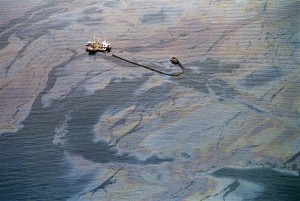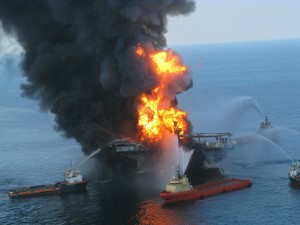While preparing my latest blog (on zero energy buildings – to be posted shortly) I read the attached piece on the Washington Post’s OpEd page for March 29, 2014: “We Still can’t clean oil spills”. It was authored by Frances Beinecke, president of the Natural Resources Defense Council, and because I think it is a very important article I am reprinting it here to facilitate its distribution. BP, Exxon and other oil companies can advertise all they want about their commitment to safety, but advertising doesn’t substitute for investments in safety research and deployment of safety equipment and practices in an industry that will inevitably experience accidents. Reduced dependence on oil is the long-term strategy that we also need to pursue aggressively.
“25 years after Exxon Valdez, we still haven’t learned to limit oil drilling
By Frances Beinecke, Published online on March 28
Frances Beinecke is president of the Natural Resources Defense Council. She was a member of the National Commission on the BP Deepwater Horizon Oil Spill and Offshore Drilling.
Twenty-five years ago this month, the Exxon Valdez struck a reef in Alaska’s Prince William Sound and dumped 11 million gallons of crude oil into the water. The public was shocked by photos of oil-soaked otters and reports that coastal residents had lost their livelihoods. The cleanup effort was so vast it required 11,000 people, some of whom scooped up oil with buckets. People were outraged.
Two decades later, the Macondo well beneath the Deepwater Horizon blew out, killing 11 and sending 170 million gallons of oil into the Gulf of Mexico. I served on the National Commission on the BP Deepwater Horizon Oil Spill and Offshore Drilling, and I saw firsthand the oil-drenched beaches and the anxiety of coastal residents. It was hauntingly familiar. Many lessons from the Exxon Valdez spill had not been applied, and the country was once again struggling with an industry ill-prepared to respond.
Flash forward four years, and oil spills continue to endanger our waters. A week ago , a barge and ship collided and spilled about 168,000 gallons of thick, viscous oil into Galveston Bay near a vibrant bird sanctuary.
An even greater potential disaster looms. Shell Oil plans to drill in Alaska’s next frontier — the Arctic Ocean, a region even more pristine and remote than Prince William Sound. The company’s initial attempts were plagued by failed emergency equipment, a 32-mile-long ice floe and a grounded drill rig. If this last unspoiled ocean isn’t put off-limits in a hurry, we could witness a spill of far greater proportions.
Our country can learn from experience. Preserving marine riches for generations to come makes more sense than trying to bring them back from the brink of the latest disaster.
Here is what we know and must act on today:
The oil industry is still using the same ineffective technology to clean up oil in water as it was 25 years ago. Exxon was woefully ill-equipped for cleaning up Prince William Sound, and the industry vowed to invest in better technologies. Yet when the Deepwater Horizon spill occurred, the industry showed up with the same tools: containment booms and dispersants. Companies spent billions of dollars to advance drilling technology but only a fraction on cleanup research. They had nothing new to offer. And those booms managed to pick up just 3 percent of the oil spilled in the Gulf.
Since the BP spill, companies have increased the number of available well caps, ships and booms, but they have had few breakthroughs in cleanup ability. That is alarming for the Arctic, since booms have not proved capable of cleaning up oil in an Arctic environment shrouded most of the year in ice, fog and gales.
This is particularly important since we now know that oil lingers for decades. In 2003, researchers found that more than 21,000 gallons of oil from the Exxon Valdez tanker remained in Prince William Sound, and some is still present. A recent study concluded that the region’s harlequin duck and sea otter populations have rebounded — but that took 24 years. Pacific herring have reached only 15 percent of pre-spill levels, gutting what was once a $12 million fishery in Prince William Sound. And while one pod of orca whales hit hard by the spill is recovering slowly, the other is headed for demise.
In Louisiana, oil from the Deepwater Horizon spill continues to wash ashore, and researchers are just beginning to understand its effects on the food chain. It’s clear that oil spills cannot be wiped away in a matter of months or a few years, and they can imperil wildlife for generations. Our remaining polar bears and some of our last beluga whales must not be exposed to the same dangers in the Arctic Ocean.
Congress has failed to strengthen safeguards for offshore drilling since the Gulf of Mexico disaster. Just one year after the Exxon Valdez spill, Congress passed the Oil Pollution Act and generated important improvements in tanker safety. Yet in the aftermath of the larger spill in the Gulf, Congress hasn’t passed a single law to rein in an industry known for reckless operations and resistance to oversight.
It is long past time for Americans to hear what oil disasters keep telling us: Our safeguards and cleanup equipment aren’t sufficient, and our oceans and coasts remain vulnerable to long-term damage.
The oil industry and Congress must fill the holes in our safety net and recognize that some places should be off-limits to drilling. The fragile and beautiful Arctic Ocean is one of them. I do not want to mark the 25th anniversary of the Deepwater Horizon spill by reflecting on an oil disaster in the Arctic. Let us learn from history and create a safer, clean energy future.”


